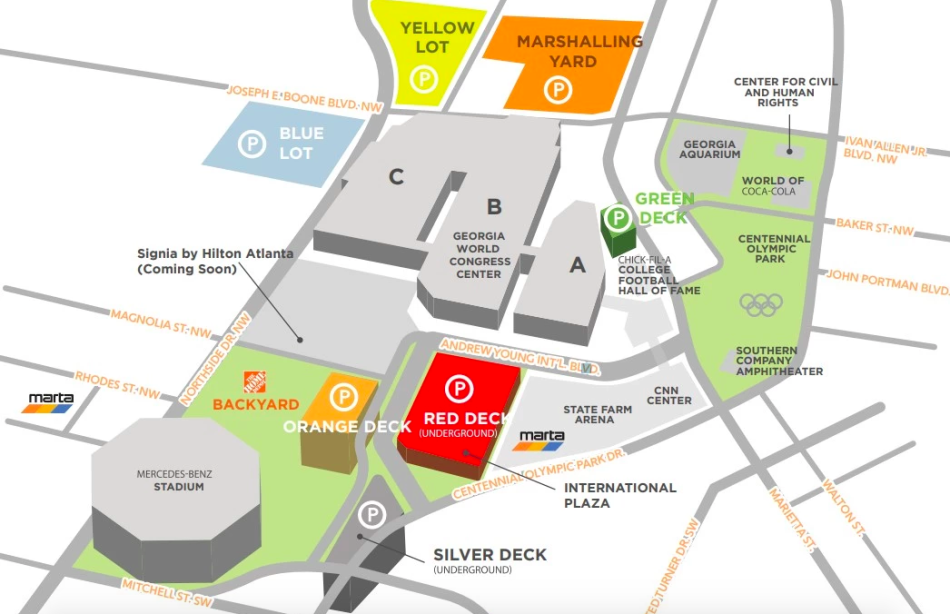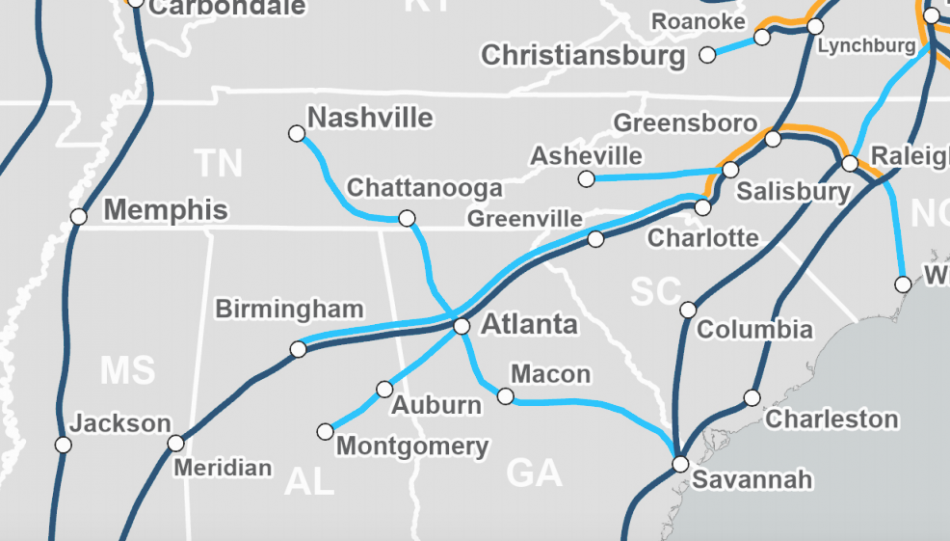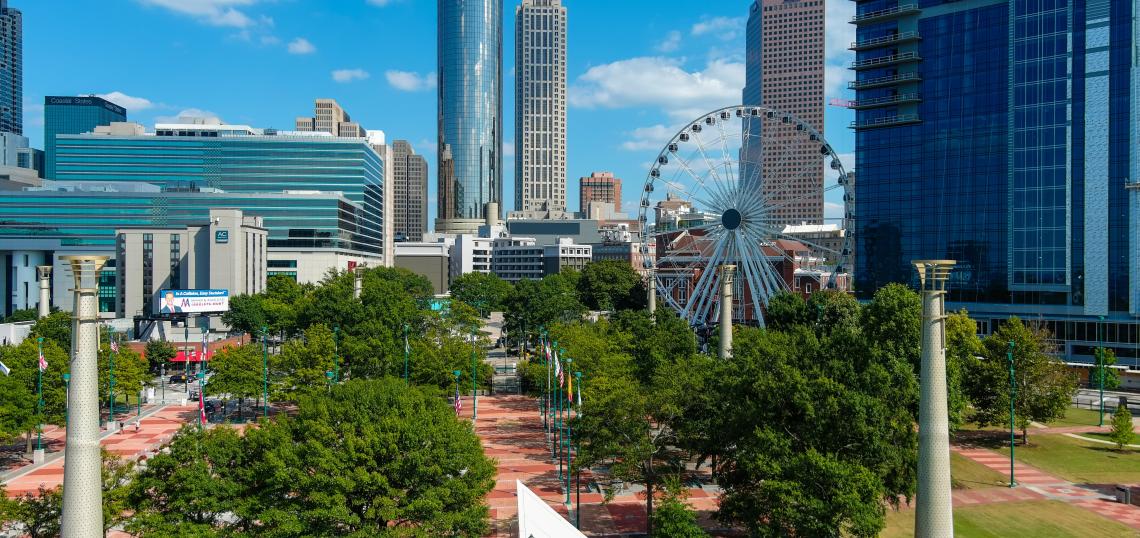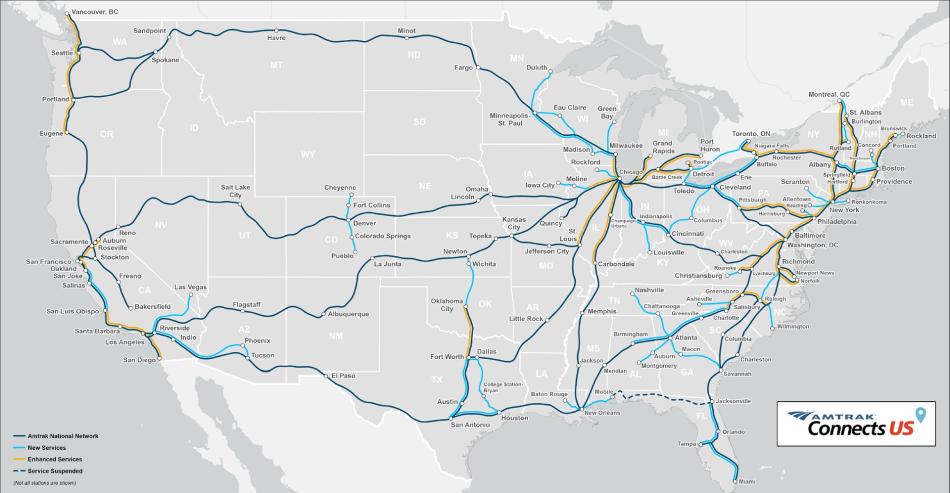Specific plans remain hush-hush, but Amtrak’s pick for a new multi-modal hub site in Atlanta ranks among the most compelling topics for urbanists around the city.
Could a clue have emerged this week from, of all places, a corporate retreat?
A masterplan presentation at Georgia World Congress Center Authority’s board retreat this week indicates the state agency is at least considering the mobility impacts of a potential Amtrak hub being located near its massive, 220-acre downtown campus, where multiple phases of mixed-use redevelopment are being considered. The board went into executive session to protect discussions related to the presentation, according to a Wednesday agenda.
One GWCCA objective is to “leverage transportation improvements like the Amtrak multi-modal hub and the Beltline to enhance connectivity and attract future developments,” notes the masterplan document. “This supports the vision of making the area more accessible and pedestrian-friendly.”
A well-connected downtown source separately tells Urbanize Atlanta that Amtrak and GWCC have been in discussions, but that’s unconfirmed.
A GWCCA spokesperson wrote via email today that Amtrak was “not discussed at all” during the Wednesday retreat. “Beyond that,” the spokesperson tells Urbanize, “we can’t comment on anything discussed during executive session.”
What’s certain is that both Amtrak and GWCCA have entered ambitious expansion modes.
Amtrak’s general and legislative annual report for fiscal year 2025 includes a request for nearly $30 million in federal funding to secure a development site for a new intercity rail hub in Atlanta—and to start the process of building it. In an email to Urbanize in July, officials with America’s National Railroad Passenger Corporation praised Atlanta’s potential as a strategic hub location, but they didn’t divulging where it could be built.
Amtrak has pinpointed intown Atlanta for a new station that could cost hundreds of millions of dollars and, eventually, reestablish the city as the important rail hub it historically was, as part of Amtrak’s national growth spurt and hiring spree. According to Amtrak’s report, some of the Atlanta land in question is “at imminent risk of development,” but the location is referred to only vaguely as being downtown. Whether “downtown” actually means downtown Atlanta, or is a general reference to more urban parts of the city, isn't yet clear.
“We are excited to work with local, state, federal, and railroad partners to help secure a site for an improved and expanded Amtrak station in Atlanta,” reads a July statement provided by Amtrak.
Meanwhile, in May, nascent plans came to light for a potential $1.1 to $1.3-billion mixed-use growth phase around the GWCC.
Designs compiled by Atlanta-based architecture firm HKS marked the GWCCA’s first masterplan since 2008, prior to a major convention center expansion, the construction of its Mercedes-Benz Stadium, and other updates to campus. In general, the new development strategy calls for hotel rooms, housing, offices, and retail space—some of it directly linked to a multi-use Atlanta BeltLine connection trail, the Westside Beltline Connector—on what’s underused land today. The result could be a more robust convention business and more developed blocks around Atlanta’s Westside, especially in Vine City, per designers.
More recently, GWCCA officials selected a development team to transform the 11-acre Home Depot Backyard (the Georgia Dome’s former site) into a new entertainment district spanning up to 250,000 square feet. That team includes Atlanta development firm Fuqua Development, local investment and development company Pope and Land Real Estate, and Minneapolis-headquartered architects Nelson Worldwide—the same partnership that created The Battery Atlanta. Exactly what the project might entail, what it might cost, and when it could break ground hasn’t been detailed.
 The two main development sites in question (at top). Property adjacent to MARTA’s GWCC/CNN Center station is also being considered. GWCCA
The two main development sites in question (at top). Property adjacent to MARTA’s GWCC/CNN Center station is also being considered. GWCCA
As revealed on these pages in June, Amtrak’s $29.9 million grant request for “Atlanta Hub” would support property acquisition to preserve future railroad right-of-way and "ensure that the Hub station site can be connected with existing main line track,” per the Amtrak report. The funding would also help cover early phase prerequisites such as engineering and work to have the project cleared under the National Environmental Policy Act, or NEPA.
But that funding would only be a start.
Amtrak estimates the new Atlanta facility would cost roughly $700 million once needed infrastructure investments are factored in. That includes new trackage to separate passenger service from freight operations.
The Atlanta City Council passed a resolution in 2022 urging Amtrak to consider downtown as a viable location for a rail hub; at the time, the $5-billion Centennial Yards megaproject was considered the leading alternative, with the Armour Yards district near Lindbergh also being mentioned. In April, Armour Yards was revealed as one of four locations where Atlanta Mayor Andre Dickens wants to see BeltLine-connected MARTA infill stations built in coming years, though how those would be funded remains a question mark. Centennial Yards, meanwhile, is teeming with construction for the initial phases of a massive mixed-use district.
The request for Atlanta funding came as part of $4 billion in Amtrak grant requests for base needs and modernization of its system as passenger numbers are on the uptick. Amtrak leadership has said the company is on pace to grow its ridership to 66 million annual passengers—more than doubling peak ridership in pre-pandemic 2019—by 2040.
In fiscal year 2025, Amtrak expects ridership to reach nearly 35 million.
 As presented in 2024, Amtrak's goals for rail service expansion around the Southeast, with Atlanta as the hub. Light blue represents new rail lines; yellow, enhanced services; and dark blue is Amtrak's existing national network. Amtrak
As presented in 2024, Amtrak's goals for rail service expansion around the Southeast, with Atlanta as the hub. Light blue represents new rail lines; yellow, enhanced services; and dark blue is Amtrak's existing national network. Amtrak
Atlanta’s current Amtrak station was built in 1918 in what was then a suburban setting, designed for a small number of passengers. Other drawbacks include no parking, no connections to local transit, an undersized waiting room, and poor access from the station building to its single platform below, which is a particular challenge for disabled passengers, the Amtrak report notes.
Amtrak has signaled interest in recent years to reestablish Atlanta as a predominant railroad hub, with routes fingering out to Charlotte, Nashville, Macon, Montgomery, Birmingham, Savannah, and other cities.
Today, just one Amtrak line serves Atlanta—the New York City-to-New Orleans Crescent.
Amtrak’s report states the modernized new station would boost the customer experience on the Crescent route and link Atlanta with new intercity passenger trains to cities small and large—Chattanooga, Greenville, SC, Memphis, and Meridian, MS are all named—in addition to the airport. The grant request isn’t tied to any proposals already moving through the FRA’s Corridor Identification and Development program process, but it’s compatible with that effort, per Amtrak.
...
Follow us on social media:
Twitter / Facebook/and now: Instagram
• Downtown news, discussion (Urbanize Atlanta)








